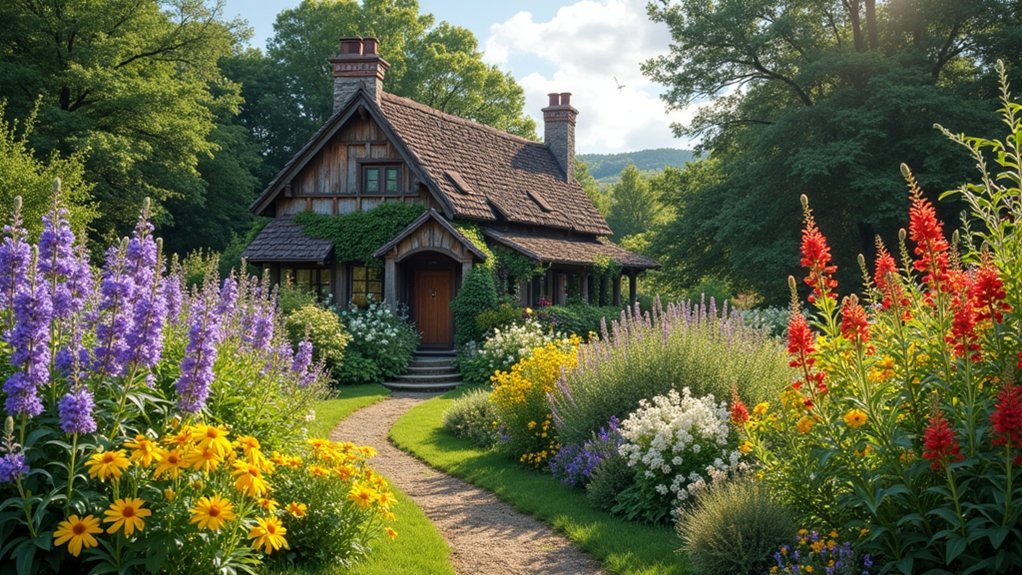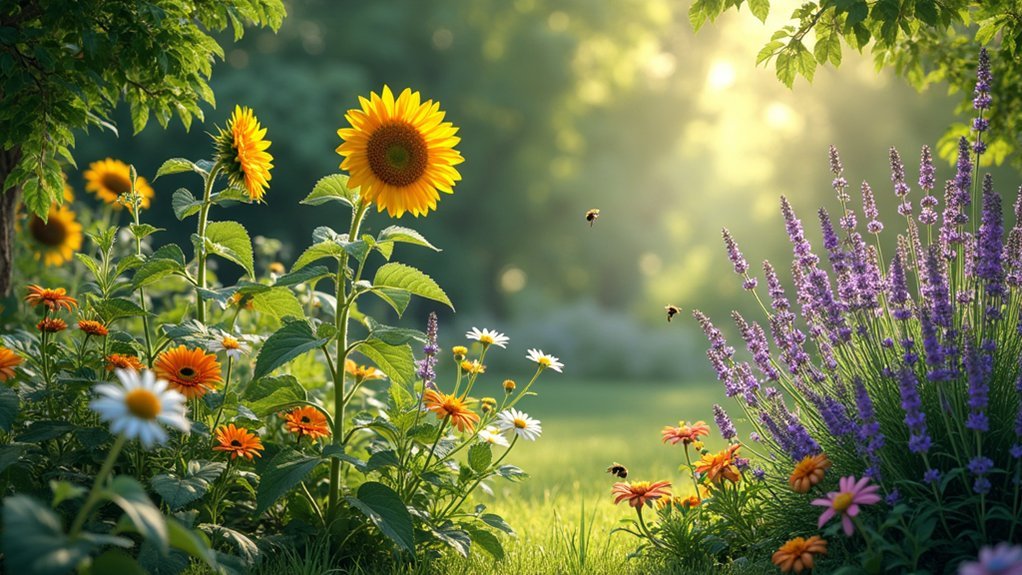Perfect pollinator cottage boundaries combine traditional favorites like lavender, honeysuckle, and campanula with strategic layering techniques. Plant tall delphiniums at the back, medium-height perennials in the middle, and shorter hardy geraniums in front. Include early bloomers like crocus, summer flowers like coneflowers, and fall options such as asters to support pollinators year-round. Native plant combinations like Liatris with Echinacea create stunning visual appeal while establishing essential habitat corridors for your buzzing garden visitors.
Traditional Cottage Garden Plants for Pollinator-Friendly Boundaries

While creating natural boundaries in your garden, traditional cottage plants offer both beauty and ecological benefits.
Lavender thrives in sunny spots with minimal care, providing fragrant blooms that attract bees and butterflies to your garden’s edge.
Honeysuckle’s relaxed, spreading habit makes it perfect for fences and arches, with its tubular flowers drawing in pollinators from July through September.
Consider adding Campanula with its bell-shaped blue flowers that bees adore throughout an extended blooming season.
Bell-shaped Campanula creates a buzzing oasis, delighting bees with its extended blue bloom cycle.
Don’t overlook Aquilegia’s distinctive bonnet-shaped blooms, which bridge the gap between spring bulbs and summer flowers while providing essential nectar for early-season pollinators.
For dramatic height, Delphiniums create impressive backdrops with their towering spires, attracting hummingbirds to your pollinator-friendly boundaries.
Layering Techniques for Creating Dynamic Living Fences
Creating a truly effective living fence requires thoughtful layering that mimics nature’s own vertical structure. Position tall flowering perennials like delphiniums at the boundary’s back, then gradually step down to medium-height plants, finishing with shorter varieties like hardy geraniums at the front.
When implementing these layering techniques, plant in drifts rather than single specimens. Group lavender and phlox together to create concentrated feeding stations that attract and sustain pollinators. This approach makes your pollinator garden more visually compelling while supporting foraging efficiency.
Incorporate evergreen shrubs as your year-round backbone, then weave in seasonal bloomers that provide continuous nectar. By carefully arranging plants that flower in succession—peonies in spring, campanula in summer, and asters in fall—you’ll maintain a boundary that’s both beautiful and biologically active throughout the seasons.
Year-Round Blooming Strategies for Continuous Pollinator Support

Successful pollinator boundaries rely on strategic bloom scheduling throughout the seasons. You’ll want to incorporate early, mid, and late-blooming native plants to guarantee continuous flowering from spring through fall.
Start with spring bloomers like crocus and snowdrop, shift to coneflowers and bee balm for summer, and finish with asters and goldenrod in autumn.
When selecting plants, focus on creating overlapping bloom times—pairing phlox with lavender maximizes nectar availability and attracts diverse pollinators.
Include various flower shapes and colors to support different pollinator species throughout their life cycles.
Don’t forget to deadhead spent blooms regularly to extend flowering periods and encourage self-seeding varieties that naturally perpetuate your year-round blooming strategy.
This approach maintains a steady food source for pollinators while keeping your cottage boundary visually dynamic.
Native Plant Combinations That Thrive as Natural Borders
Natural boundaries flourish when you combine native plants that complement each other’s growth habits and blooming periods.
Creating these living borders with native plants provides essential habitat for pollinators while defining your cottage garden’s edges with seasonal interest.
- Pair tall *Liatris spicata* (blazing star) with mid-height *Echinacea purpurea* (purple coneflower) for a purple-hued border that attracts bees and butterflies throughout summer.
- Combine golden *Rudbeckia hirta* (black-eyed Susan) with orange *Asclepias tuberosa* (butterfly weed) to create a monarch haven with contrasting colors.
- Plant *Amsonia tabernaemontana* (blue star) alongside *Schizachyrium scoparium* (little bluestem) for spring blooms followed by distinctive fall foliage.
- Layer different heights of native perennials to create depth while ensuring continuous blooming from spring through fall.
Design Elements for Cottage-Style Pollinator Corridors

When you plan cottage-style pollinator corridors, the careful layering of plants creates both visual interest and functional habitat for beneficial insects.
Structure your garden with tall flowering plants like Delphiniums and Hollyhocks at the boundary’s back to provide a natural backdrop and vertical dimension.
Weave winding pathways through your garden, bordered by vibrant Coneflowers and Phlox that guide both visitors and pollinators.
For year-round appeal, incorporate flowering shrubs such as compact Lavender or Prairifire Crabapple.
Edge your corridors with Silver Carpet Lamb’s Ears and Hardy Geraniums, creating soft borders that pollinators adore.
Frequently Asked Questions
What Plants Are Best for a Cottage Garden?
For your cottage garden, you’ll love planting aquilegia, hardy geraniums, dianthus, lavender, and hollyhocks. They’ll create charming displays with their colorful blooms while attracting beneficial pollinators to your outdoor space.
What Plant Attracts the Most Pollinators?
Milkweed attracts the most diverse pollinator range, serving as Monarch butterflies’ essential host plant while drawing numerous bees and other butterflies. You’ll see constant pollinator activity when you’ve planted this nectar-rich perennial in your garden.
What Is the Best Landscaping for Pollinators?
Plant diverse native flowers that bloom throughout the season. You’ll attract more pollinators with clustered plantings of coneflowers, bee balm, and lavender. Don’t forget to include shrubs and grasses for nesting sites.
How Do You Layout a Pollinator Garden?
Design meandering paths through your pollinator garden, layering plants by height and staggering bloom times. Include native species, create diverse textures, and don’t forget seating areas where you’ll enjoy watching the buzzing visitors.
In Summary
You’ve now opened the secret to perfect pollinator cottage boundaries! By combining traditional cottage favorites with native plants in thoughtfully layered designs, you’ll create living fences that buzz with life year-round. Remember, it’s the strategic bloom succession that keeps pollinators returning season after season. Your cottage boundary isn’t just a border—it’s a wildlife corridor that connects your garden to the wider ecosystem.





Leave a Reply